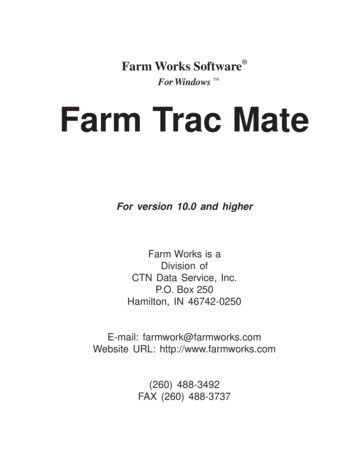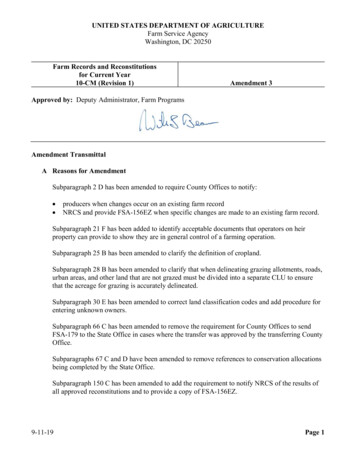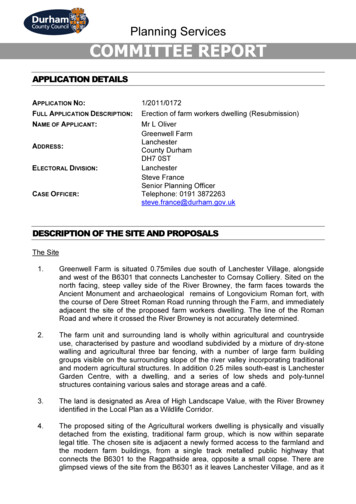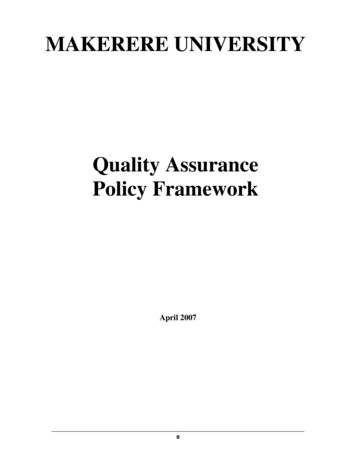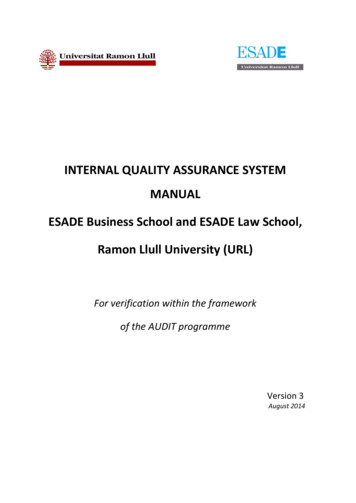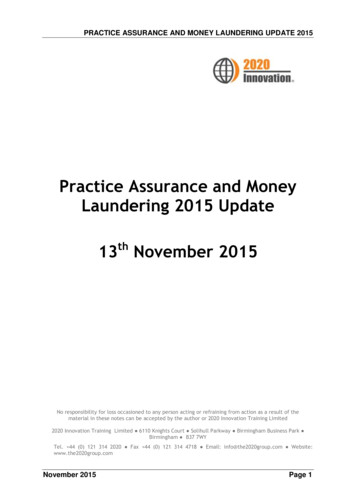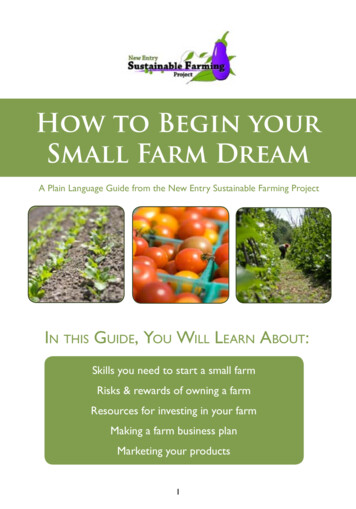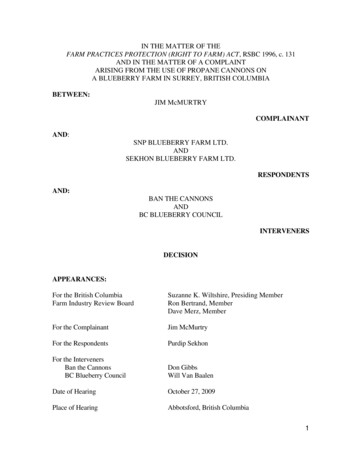
Transcription
LPA On-Farm QualityAssurance manual
Manual
21383-MLA LPA QA Manual V2 NEW22/9/063:56 PMPage 1Part A: General information about LPA Quality Assurance1.0 What is qualityassurance?Quality assurance means being able to assurecustomers that you can produce a quality product tomeet their specifications the same way every time. It isthe customers who define quality.A quality assurance system involves: putting in place documented procedures whichidentify the methods for carrying out each keyproduction task recording the results of those actions checking that the results conform to expectations implementing corrective and preventive actions onall identified problems, to stop identified problemsoccurring againOnce a business starts down the quality assurancepathway, it is logical that they will want the assurancethat their suppliers also have in place systems toensure the quality and consistency of their products.In terms of the red meat industry, livestock producersare those suppliers, with our customers requiring theassurance that the food products that we supply areproduced under a quality assured management system.The Standards that underpin the LPA On-Farm QualityAssurance (LPA QA) program are HACCP based. TheLPA QA Standards have been developed to provide aframework for producers to be able to readily adoptquality assurance systems on their properties.The Cattlecare and Flockcare logos and the qualitysystems that they represent are widely recognised.Integral to all quality assurance programs is an auditingcomponent. Through the audit and accreditationprocess, producers can demonstrate with confidenceto domestic and overseas customers that the qualitysystems they have introduced on-farm meet thestringent quality standards represented by theCattlecare and Flockcare logos.Ultimately, customers purchasing LPA QA accreditedlivestock under either the Cattlecare and/or Flockcarelogos have the confidence that the product will meettheir requirements.1.1Benefits from LPA QAOnce implemented on the farm, the LPA QA program(incorporating Cattlecare and/or Flockcare) provides arange of benefits to both the producer and the industry.There is effort required by the producer to fullyimplement LPA QA, but this is offset by short and longterm benefits.Improved product consistencyLPA QA provides a system to reduce bruising and othercarcase damage, reduce damage to skins and reducethe chance of unwanted chemical residues.Risk managementWith a quality assurance system in place, producersare able to prove they have been following industrystandards, and may be able to reduce the chance oflegal claims against them.Greater professionalismParticipation in LPA QA will mean better recordkeeping, better staff training, clearly defined areas ofresponsibility and awareness of the customerrequirements for product quality. This will also enhancethe reputation of primary producers in the marketplace.International recognition and market accessQuality assurance can provide entry to specificmarkets. It is important for our industry to adopt aglobal view, being proactive rather than reactive.Product differentiationLPA QA accredited producers are able to sell a brandedproduct identified by the Cattlecare and/or Flockcarelogos. This may result in marketing opportunities as theindustry moves towards a multitude of product brands,encompassing a wide variety of quality attributes frompaddock to plate. It may also assist the development ofstrategic alliances between producers, processors andconsumers.The structure of LPA QA enables a producer to addvarious modules to suit their business operation,allowing them to differentiate their product under arecognised QA system. This can be delivered through asingle whole of farm QA program within a combinedaudit.Issue 1 – October 20061
21383-MLA LPA QA Manual V2 NEW22/9/063:56 PMPage 2Part A: General information about LPA Quality Assurance1.2 How do the LPA foodsafety and QAprograms interact?The LPA food safety program (level 1) provides a set ofguidelines and a National Vendor Declaration (LPA NVD)to help producers declare the food safety status of theirlivestock. The LPA food safety program guidelinespresent producers with basic animal production andrecord keeping requirements designed to ensure theproduction of safe food.Producers wishing to move to the next level of LPA,being the LPA QA program, have already met some ofthe requirements through the implementation of theLPA food safety program.The food safety management module in this program isbased on the original standards of the LPA Level 1 foodsafety program. Therefore, as a producer in the foodsafety program, you are already one third of the way toprogressing accreditation in LPA QA.1.3 LPA QA StandardsThe On–Farm Quality Assurance Standards aremaintained by the LPA Standards and AccreditationCommittee (LPASAC). This committee is convened byMeat & Livestock Australia (MLA) to manage thestandards for both LPA level 1 and the LPA QAprogram.The requirements for the LPA QA program, includingeach element, are detailed within the LPA QAStandards. Each element has a specified outcomewhich must be met in order to demonstrate that therequirements of the program are being met.In addition to a stated outcome, each element has oneor more performance indicators which represent theactual standard to which a producer seeking to gain ormaintain accreditation is assessed, to determinewhether the designated outcome is being achieved.Details of the performance indicators are included inthe LPA QA Standards, in the LPA On-Farm QualityAssurance manual (LPA QA manual).2.0 The modules andelements of the LPAQA programTo become accredited to the LPA QA system, it isnecessary to meet all relevant elements of the LPA QAStandards.There are three key modules within the LPA QAStandards, with each module comprising one or moreelements. Each module is colour coded to assist inidentification of relevant sections (refer table 1).Individual producers cannot change requirementswithin the LPA QA Standards, however they are able torequest changes via LPASAC.When changes to the Standards are introduced,accredited producers are advised of changes and theyhave the responsibility to update the existing Standardwith the new version and implement changes.Table 1: Modules of the on-farm quality assurance standardModuleStandard modules1Food safety management2Systems management3Livestock management4Optional modulesOptional modules #Examples include environment, JapaneseAgricultural Standard (JAS), OH&S andsupermarket requirements# Meat & Livestock Australia (MLA), on behalf of industry is currently leading research projects related to the proposeddevelopment of a number of additional optional modules, including environment, Japanese Agricultural Standard (JAS)and supermarket requirements. These optional modules will be introduced as they become available.2Issue 1 – October 2006
21383-MLA LPA QA Manual V2 NEW22/9/063:56 PMPage 3Part A: General information about LPA Quality AssuranceModules 1 to 3 are classified as ‘standard’ modulesrepresenting the minimum standard. That is, allproducers seeking accreditation in Cattlecare and/orFlockcare must meet the requirements of thesemodules.Optional modules may also be adopted by accreditedproducers to assist them in meeting customerrequirements and/or further differentiating theirbusinesses.For each of the elements within the three modules thereis an outcome. To maintain LPA QA accreditation,producers must comply with all elements and theiroutcomes. A number of practical on-farm activities forachieving each element are contained in the fullStandards which are summarised in the ‘Moduleactivity guidelines’ of the LPA QA manual. Producersmay be able to show they meet the outcome(s) byusing some other means.It is important to note that the food safety managementmodule incorporates all requirements of LPA level 1 asdescribed in the Guide to the LPA NVD Waybill and theLPA Standards. To progress the implementation of LPAQA, a producer only needs to implement therequirements of modules 2 and 3, given that therequirements of module 1 should already be in place. Agraphical representation of the interaction of thevarious modules that constitute the LPA QA program isshown in figure 1 below.Figure 1: Graphical representation of the interaction of the various modules within the LPA QA standardsLevel 1Level 2Optional module 3Module 1Module 2Module 3Optional module 2Optional module 1 LPA level 1 foodsafety Systemsmanagement LivestockmanagementBase LPA QA accreditation requirementsCan be implemented byproducer if requiredAccreditation in LPA QA enables an accredited producer to utilise the following logosIssue 1 – October 20063
21383-MLA LPA QA Manual V2 NEW22/9/063:56 PMPage 4Part A: General information about LPA Quality Assurance3.0 Steps to gainingaccreditationThe key steps in progressing accreditation in LPA QA(including Cattlecare and Flockcare) are outlined below:1. Read through each module, element andactivity guide in the LPA QA manual.2. Review the LPA QA Standards for additionaldetails on the standards required to be met.3. Check your own farm management systemagainst the LPA QA Standards, addressing anygaps identified.4. Start recording the information that is requiredby the standards. You may already be recordingsome or all of the information required. There isno need to duplicate this, although you need toensure your records are easily accessible forauditing purposes, as well as for your own farmmanagement.5. Ensure that at least one person on the farm hascompleted recognised training (Chemical UserCertification) equivalent to the level 3competency units of ‘Prepare and ApplyChemicals’ and ‘Transport, Handle and StoreChemicals’.6. When you think you have completed allrequirements of the LPA QA Standards, conductan initial internal audit, checking that therequirements of each element have been met.7. Contact an approved auditor and arrange foran inspection of your property. A list of auditorscan be obtained from the national serviceprovider, or visit the MLA website:www.mla.com.au/lqs8. Once you have met all the requirements of theLPA QA Standards, the auditor will recommendyour enterprise for accreditation.4Issue 1 – October 2006A schedule for implementing the various key activitieswithin the Standards is provided in table 3.A set of blank recording forms for use by participants iscontained in the example form section of the LPA QAmanual. It is important to note that these forms areprovided as examples only. If there is already arecording system on the farm which meets therequirements of the QA Standards (for example acomputer system or some other comprehensivesystem), it is acceptable to keep using the existingsystem.If you intend to use the example blank forms containedin the LPA QA manual, it is recommended that theseare photocopied before you start.
Immediately, or whenpurchasing stockfeedImmediatelyWeek 12Week 16Livestock transportInternal auditsAccreditation auditIssue 1 – October 2006Contact approved auditors that service your region to establish mostcost effective rate. Work in groups if possible.Conduct own internal audit prior to contacting auditor for accreditation audit.Use acitvity guide or blank Internal Audit Report and Checklist as included in theLPA QA manual. Note: remember to obtain copies prior to use.Inspect livestock transport trucks.Check and repair own livestock crate if necessary.Obtain Commodity Vendor Declarations (CVDs), By-product Vendor Declarations(BVDs) or suitability statements from suppliers. Record livestock feeding activities.Inspect livestock yards.Implement regular maintenance program(may develop documented plan for major repair).StockfeedintroductionsDraw/obtain map or aerial photograph.Week 3Week 1 if notalready in placeProperty map andyearly plannerKeep information required – identify, observe withholding periods/ESI /quarantine periods. Assess stock of unknown residue status.Yard inspectionsImmediately, if notalready in placeTreatment recordsKeep information required.Develop job descriptions for all staff (note: recommend using examplesin the LPA QA manual as a guide).Immediately, if notalready in placePurchase andsales recordsDescribe and document the system of livestock identification for alllivestock (including introduced/purchased livestock).Week 2ImmediatelyLivestockidentificationsystemAttend workshop if not already attended and complete farm chemicaluser training.Job descriptionsWeek 1 –organise dateChemical userscourseIdentify potential risk areas, seek advice on management of risk, obtaintraceback information from local Departments of Agriculture or RLPBs.Audit reportAudit inspection report,corrective action requestsRecord any ord activitiesRecordsRecordsRecordsAttendance certificate,other trainingRecords and documentationCOMPLETE3:56 PMCommence inventory, segregate chemicals, and isolate obsolete chemicals.Fix up storage area.Immediately, if notalready in placeProperty riskassessmentACTION22/9/06Chemical purchases, Immediately, if notstorage areaalready in placeCOMMENCEACTIVITYTable 2: Suggested activity schedule for progressing accreditation21383-MLA LPA QA Manual V2 NEWPage 5Part A: General information about LPA Quality Assurance5
21383-MLA LPA QA Manual V2 NEW22/9/063:56 PMPage 6Part A: General information about LPA Quality Assurance4.0 Producer accreditationTypeExample of non-conformanceOnce a producer has achieved the requirements of theLPA QA Standards (Cattlecare/Flockcare), they areentitled to sell livestock as conforming product.Observationnot initialing or signing records thatneed to be ‘signed off’Minorfailure to adequately record animaltreatmentsMajorfailure to identify individually treatedlivestock – unless operating a mobbased management system (iepresumes all livestock are treatedeven if only one animal is treated)Details of all accredited producers are updated to theprogram website to enable third parties to check theaccreditation status of a producer/property.Accredited producers are entitled to utilise theCattlecare and/or Flockcare logos (as applicable) toassist in the marketing of their product.4.1 Audit frequencyThe LPA QA Standards are required to be audited byqualified accredited third party (external) auditors.During the first year, two audits are completed: theinitial accreditation audit and a surveillance audit at asix month interval. Thereafter, external audits areconducted at twelve monthly intervals unless problems(non-conformances) are encountered, in which caseexternal audit frequency may be increased. In addition,accredited producers are required to conduct aminimum of one internal review per annum of theirmanagement and record keeping systems (internalaudits).When a producer seeking to gain accreditation candemonstrate that they already operate under arecognised quality system (Cattlecare, Flockcare orNFAS accreditation) and have successfully completedtwo external audits, the producer can request thataudits be conducted on annual basis, commencingfrom the initial accreditation audit.Producers are required to ‘self-monitor’ and correctproblems when they arise, not wait until an audit is due.4.2 Non-conformancesAs in the LPA food safety program, the term nonconformance is used to describe areas of the LPA QAStandards that have not been observed by theproducer or their staff. Non-conformances areassessed in accordance with the severity of the issue.There are three ‘grades’ of non-conformance:observations, minor non-conformances and majornon-conformances (see box).failure to check stock for treatmenttags or marks before dispatchfor saleTo preserve the integrity and credibility of the LPA QAStandards, sanctions will apply when major nonconformances arise. Major non-conformances mayconsist of a single occurrence, a number of separatenon-conformances, or failure to take corrective actionwhen a complaint or non-conformance has beenreceived or observed.These sanctions may range from increased (morefrequent) audit frequency to suspension or withdrawalof accreditation. Importantly, producers should notregard the identification of a major non-conformance asdetrimental; rather, it should be viewed as amanagement tool to improve the enterprise.4.3 LPA QA manual updatesThe LPA QA Standards are a ‘living’ document whichundergoes review on a regular basis to ensure that itcontinues to meet the requirements of stakeholdersand consumers alike. Whenever a change to the LPAQA Standards is introduced, program participants arenotified of the changes.4.4 Further informationFor additional information on the LPA QA program ortechnical advice on implementing the program call thenational helpline on 1800 683 111. Backgroundinformation on the LPA QA program, including commonquestions, useful links and blank recording forms, isavailable on the MLA website: www.mla.com.au/lqsIn addition, there are a number of accredited trainersoperating in each state and territory who regularly runpractical courses in regional areas. Whilst not aprerequisite, many producers consider the ability tointeract with a trainer is of great benefit whenintroducing an on-farm quality system.Contact details for trainers are available from either theMLA website or the helpline.6Issue 1 – October 2006
21383-MLA LPA QA Manual V2 NEW22/9/063:56 PMPage 7Part A: General information about LPA Quality Assurance5.0 Module activity guidesTo check you meet the LPA QA Standards:The module activity section of the LPA QA manual isyour working guide to meeting the LPA QA Standards.It provides more detail on LPA QA requirements andhas been designed so you can work through theserequirements, reviewing what you have in place alreadyand identifying anything you might need to do. Review what you need to do. Complete the selfcheck in the left hand column and determinewhether this is relevant to your operation.How to use the module activity guides Look at the ‘keep evidence of what you have done’records.These are the practical guides to meeting LPA QAStandards. You will need to spend time going throughthe guides in detail. Many producers may find they aredoing the things identified but do not have thenecessary evidence to demonstrate this – in whichcase the ‘keep evidence of what you have done’ and‘prepare for an audit’ sections under each LPA QAelement will provide further guidance. Other producersmay need to put in place new practices or records onfarm. Whichever category you fall into, the guidelines inthis section will help you identify what you need to do.A more detailed Internal Audit Report is provided inSection 8.0 of this manual (Self Audit Checklist). Check the practical ways you can meet what theelement requires, and complete the self-check in theleft hand column. The ‘prepare for an audit’ section enables you toconsider some of the questions an auditor mayask you.When completing the self-check, use: 3 to indicate you already comply 7 to indicate you need to implement something inorder to comply with the requirement ? to indicate you are unsure and should seek furtherinformation (refer to the contacts section) NA to indicate this requirement is not relevant toyour operationImportant! The module activity guides are just that, guides only. The guidelines are kept broad to cover mostsituations. They do NOT include every possiblescenario of what a producer must do to comply withthe LPA QA Standards. A complete copy of the LPA QA Standards(including the outcomes and performance indicators)is provided as part of the LPA QA manual. The LPAQA Standards are also available from the MLAwebsite: www.mla.com.au/lqs In all cases, how you keep the information is up toyou. You can use these guidelines to check youhave the information in place.Issue 1 – October 20067
21383-MLA LPA QA Manual V2 NEW22/9/063:56 PMPage 8Part A: General information about LPA Quality Assurance6.0 Optional modules7.0 LPA QA program logosExplanationProducers who gain accreditation in the LPA QAprogram (Cattlecare and/or Flockcare) are entitled toutilise the respective program logos to demonstrate tocustomers that their enterprise is accredited in arecognised red meat industry quality assuranceprogram.The main benefit of implementing the LPA QA programis that it provides the accredited producer with an entryto a selection of programs that are owned or managedby certain companies or countries, or are genericindustry programs managed by companies such asMLA.The standards of these programs may be quite similarto those of the LPA QA, so where there is industrydemand, the LPA QA program will undertake a gapanalysis of the program’s standards and the LPA QAStandards. The gap analysis will identify those areasthat are common between LPA QA and the nominatedprogram. At the completion of this analysis, thoserequirements that are above and beyond that of theLPA QA Standards are identified and incorporated intoan LPA QA optional module.These modules are split into three groups, being: commercial modules country modules industry modulesAccredited cattle producers may utilise theCATTLECARE logo in accordance with the programrules, which are detailed in the document Rulesgoverning the use of the CATTLECARE logocertification mark.Commercial modulesCurrently, modules are being progressed to meet thestandards of the major domestic supermarkets’ QAprograms as well as systems for underpinning brandedproduct supplied by Australian processing companiesor alliances.Country modulesCountries that Australia exports red meat product toare becoming more concerned with standards. This hasled to the formation of country specific brands orprograms that are either mandatory for import into thatcountry or are used as generic brands. Currently,modules are being progressed for the JapaneseAgricultural Standard (JAS).Industry modulesMLA on behalf of industry is currently leading researchprojects relating to the proposed development of anumber of industry modules. These modules are beingdeveloped with other stakeholders, including the wooland grains industry. They include: environment animal welfareThese optional modules will be progressivelyintroduced as they become available.8Issue 1 – October 2006Accredited sheep producers may utilise theFLOCKCARE logo in accordance with the programrules, which are detailed in the document Rulesgoverning the use of the FLOCKCARE logo certificationmark.
21383-MLA LPA QA Manual V2 NEW22/9/063:56 PMPage 9Part A: General information about LPA Quality Assurance8.0 Example record formsA summary of example record forms is provided below.It is important to note that there is no specificrequirement to use these forms, which have beenprovided as a guide only.Where necessary, these forms can be adapted to suitindividual management requirements.A copy of each example is provided. It isrecommended that you make a photocopy of theform you wish to use prior to use.ModuleSectionForm IDOld form IDForm nameFood safetyFS1Form C1/06Form C1/98Property risk assessment recordsFood safetyFS2Form L7/06Form L7/98Stock treatment recordFood safetyFS3Form C3/06Form C3/00Paddock, crop and grain treatment recordFood safetyFS3Form L8a/06Form L8a/98Purchased feedstuff inventory formFood safetyFS3Form L8b/06Form L8b/98Feeding record for purchased feedsFood safety/livestockFS4, FS5Form L3a/06Form L3a/98Identification records for introduced or purchasedlivestockFood safety/livestockFS5Form L2/06Form L2/98Livestock identification records for stock born andreared on propertyFood safety/livestockFS5Form L3b/06Form L3b/99Livestock transaction/sales recordsSystemsSM1Form M1/06Form M1/98Employee training and job responsibility recordSystemsSM1Form M1a/06Form M1/9Staff duties and training recordSystemsSM2Form M2a/06Form M2a/98Internal Audit Report and ChecklistSystemsSM3Form M3/06Form M3/98Quality records – archive registerSystemsSM4Form M4/06Form M4/98Document control registerSystemsSM5Form C2/06Form C2/98Farm chemical inventoryLivestockmanagementLM4Form LM4/06N/ADuty of Care statement – animal welfareFood safetyFS3SAFEMEAT Commodity Vendor Declaration and ByProduct Vendor DeclarationNote:A copy of each example form may be downloadedfrom the MLA website: www.mla.com.au/lqsIssue 1 – October 20069
21383-MLA LPA QA Manual V2 NEW22/9/063:56 PMPage 10Part A: General information about LPA Quality AssuranceCommon questionsHow much does an audit cost?How long does it take to gain accreditation?The cost of audits depends upon a number of factorsincluding location, size and complexity of the enterprisebeing audited. Audit fees are not set by the programadministration, rather audits are delivered on acommercial basis by accredited auditors. Producers areencouraged to contact a number of auditors thatservice their location, to get the best price available.There is no minimum or maximum time limit forprogressing accreditation. The suggestedimplementation timetable included in the manual allowsfor up to 16 weeks, however it is ultimately up to theindividual producer in terms of the amount time onhand and the extent of changes required to existingsystems.Who can conduct audits?Producers are free to have an auditor of their choiceconduct audits. It is important to note that there is norequirement to use the same auditor every the time.Producers are encouraged to ‘shop around’ to obtainthe service that best suits their needs. Selection ofauditors is an area where producers can exercisefreedom of choice, based on availability, cost or otherfactors.Contact details of accredited auditors are availablefrom the national helpline on 1800 683 111 or the MLAwebsite: www.mla.com.au/lqsWhat qualifications are required by auditorsconducting Cattlecare/Flockcare audits?Cattlecare/Flockcare audits can only be conducted byapproved auditors. Approved auditors must beregistered to RABQSA International as either qualitysystem and/or food safety auditors. RABQSA is aninternationally recognised auditor certification bodywhich ensures that auditors meet stringent standards inrelation to auditing skills, practical experience, technicalknowledge, competency and continual personneldevelopment.In addition, accredited auditors must have agriculturalindustry experience and understanding, and haveundertaken a familiarisation course covering therequirements of the LPA QA Standards.Approved auditors are also subject to audit byCattlecare/Flockcare administration and RABQSA toensure total program integrity.Can I appeal against the findings reported by anauditor?Yes. Producers are able to appeal to the NationalService Provider against an auditor’s decision if theyfeel it is unjustified or unwarranted. Similarly, producerswill also be able to refer to the National ServiceProvider perceived variations in auditing standards, toensure uniform standards are kept across the country.10Issue 1 – October 2006Do I need to advise program administration if I sellmy property?Yes. When a property is sold, details of the sale shouldbe advised to administration.Can I transfer my accreditation between properties?No. Accreditation is NOT transferable from oneproperty to the next. When a property is sold,accreditation will be revoked. The new owners of theproperty may apply to reinstate accreditation, which willoccur once a successful audit of the new owner’squality system is conducted.When a producer sells an accredited property andpurchases another property not accredited, the newproperty can progress accreditation as per all newproperties, except that the audit frequency willautomatically revert to an annual audit.Where can I obtain a Commodity VendorDeclaration (CVD)?There are currently two industry stockfeed vendordeclarations available: Commodity Vendor Declaration (CVD) By-product Vendor Declaration (BVD)Both are available for download free of charge from theMLA website: www.mla.com.au/lqsAre there any restrictions on use of the logos?Accredited producers are entitled to use the Cattlecareand/or Flockcare logos for all livestock and product thathas been produced in accordance with programrequirements. Specific requirements in relation to use ofthe logos is contained within the respective Rulesgoverning the use of the Cattlecare and Flockcare logos.Where can I obtain current information on exportslaughter intervals (ESI)?Current ESI information is available from the AustralianPesticides and Veterinary Medicines Authority (APVMA)website, www.apvma.gov.au, or the MLA website:www.mla.com.au/lqs
21383-MLA LPA QA Manual V2 NEW22/9/063:56 PMPage 11Part B: How to meet LPA QA StandardsFood safety management activity guideElement FS1: Property risk assessmentOUTCOME: On-farm systems have been implemented to minimise the risk of livestockbeing exposed to sites that are unacceptably contaminated with organochlorine or otherpersistent chemicals.Review what you need to do to meet the requirements of this elementSelf-check3,7,? or NAWhat you need to doo Have persistent chemicals been used on your property in the past?o Identify all the sites on your property which are or might be contaminated.o Manage the animals which have been potentially exposed to the site(s) of concern.o Contact the Department of Agriculture to obtain a property residue status report and/or interprettest results or, if a new site, to conduct animal fat tests for suspect sites where animals are fedintensively, such as feedlots or weaning yards.Practical ways to implement the elementsSelf-check3,7,? or NAExamples of how to demonstrate compliance(practical things you can do on your property to meet the element outcome)o Mark on the property map suspect areas such as: old yards dip sites treated yards old rubbish dump sites treated power poleso Conduct soil tests to quantify residue risk for any sites of concern.o Conduct animal fat tests for suspect sites where animals are fed intensively, such as feedlots orweaning yards
Risk management With a quality assurance system in place, producers are able to prove they have been following industry standards, and may be able to reduce the chance of . 21383-MLA LPA QA Manual V2 NEW 22/9/06 3:56 PM Page 1. 2 Part A: General information about LPA Quality Assurance Issue 1 - October 2006 1.2 How do the LPA food
